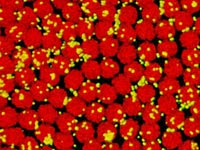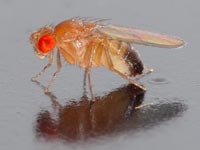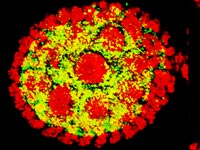Bacteria have the ability to transfer genes to one another. Now, scientists have found that one species, Wolbachia, has managed to transfer its entire genome into that of a fruit fly. These extreme gene transfers could be more common than we thought, and they have important consequences for genome-sequencing projects.
 A humble species of fruit fly is the genetic equivalent of a Russian doll – peer inside its DNA and you will see the entire genome of a species of bacteria hidden within.
A humble species of fruit fly is the genetic equivalent of a Russian doll – peer inside its DNA and you will see the entire genome of a species of bacteria hidden within.
The bacteria in question is Wolbachia, the most successful parasite on earth and infects about 20% of the world’s species of insects. It’s a poster child for selfishness. To further its own dynasty, it has evolved a series of remarkable techniques for ensuring that it gets passed on from host to host. Sometimes it gives infected individuals the ability to reproduce asexually; at other times, it does away with an entire gender.
Now, Julie Dunning-Hotopp from the J. Craig Venter Institute and Michael Clark from the University of Rochester have found an even more drastic strategy used by Wolbachia to preserve its own immortality – inserting its entire genome wholesale into that of another living thing.
Swapping genes
Among bacteria, such gene swaps are run-of-the-mill. Humans and other multi-celled creatures must contend ourselves with passing our genes to our young but bacteria have no such limits. They can exchange genes as easily as we exchange emails and this free trade in DNA, formally known as ‘lateral gene transfer’, allows them to swap beneficial adaptations such as drug resistance genes.
Until now, gene transfer between bacteria and eukaryotes was thought to be rare. But if any bacteria was well placed to do it, it would be Wolbachia. It infects the developing sex cells of its hosts and gets passed on from mother to child in the egg itself – a prime location for integrating its genes into those of the next generation.
 Other labs had already managed to detect traces of Wolbachia genes in a species of beetle and a nematode worm. To discover the full extent of its genetic infiltration, Dunning-Hotopp and Clark decided to search for Wolbachia genes in a wide range of invertebrates.
Other labs had already managed to detect traces of Wolbachia genes in a species of beetle and a nematode worm. To discover the full extent of its genetic infiltration, Dunning-Hotopp and Clark decided to search for Wolbachia genes in a wide range of invertebrates.
Hitchhiking in flies
The fruit fly Drosophila ananassae quickly emerged as a promising candidate, and the duo tried to isolate its genome by killing off the infecting Wolbachia with a simple antibiotic.
It didn’t work. Even with the antibiotic treatment, they still found traces of Wolbachia genes amidst the fly’s DNA.
For months, the same thing happened and as frustration settled in, Dunning-Hotopp and Clark realised that the fly’s cells had no living Wolbachia in them. The immigrant genes kept on turning up because they were actually part of the Drosophila genome and Clark eventually found them on the second chromosome.
Astonishingly, they found that almost all of the bacterium’s genes had been transferred across. The insert is about the right size, and when Dunning-Hotopp and Clark tested for 45 genes spread throughout the Wolbachia’s genome, they found 44 in the fly.
Through further investigation, they confirmed that the genes didn’t just come from a few resistant Wolbachia contaminating the samples. They could be passed down from father to children, something that the parasite itself cannot do for it only passes down the female line.
 Implications
Implications
Dunning-Hotopp’s and Clark’s discovery suggests that gene transfers between bacteria and more complex creatures may be much more common than previously thought. After all, in addition to D.ananassae, the team also found smaller Wolbachia fragments in six other species of insect and four species of nematode worm.
But to truly appreciate the full scale of gene transfer from bacteria to complex organisms, we need to completely rethink the way that we sequence genomes.
In the past, genome sequencing projects have discarded traces of bacterial genes because the scientists thought they were contaminations, the odd bacteria that got mixed up in the sample. And that has almost certainly led to mistakes. Case in point: the publicly available full sequence of D.ananassae doesn’t include any Wolbachia genes, because they were left out.
This isn’t a mistake that we can make lightly, for this process could be a major driving force in evolution. After all, Wolbachia is the world’s most common parasite and it infects the world’s most numerous animal groups. Its inserted genes could rapidly provide the host animal with new genes and new abilities.
Certainly, in the fly, the Wolbachia genes are not quiet stowaways and 2% are actually switched on. Whether they actually do anything is another matter – their gene transcripts are up to a million times less common than the flies’ own. Their role is a question that the researchers have yet to answer.
Nonetheless, for Wolbachia, the strategy (which Dunning-Hotopp and Clark believe was accidental) has paid off. The duo found the Wolbachia genes in D.ananassae specimens from Hawaii, Malaysia, Indonesia and India, almost unchanged. From a single ancestor that inveigled its way into the fly’s genome, Wolbachia gained a free ride across the world.
More on Wolbachia:
Butterflies evolve resistance to male-killing bacteria in record time
More on genomes and genetics:
Dinosaurs provide clues about the shrunken genomes of birds
Too few genes to survive – a bacteria with the world’s smallest genome
Chimerism, or How a marmoset’s sperm is really his brother’s
The secret of drug-resistant bubonic plague
Reference: Dunning-Hotopp, Clark, Oliveira, Foster, Fischer, Torres, Giebel, Kumar, Ishmael, Wang, Ingram, Nene, Shepard, Tomkins, Richards, Spiro, Ghedin, Slatko, Tettelin & Werren. Widespread lateral gene transfer from intracellular bacteria to multicellular eukaryotes. Science doi:10.1126/science.1142490
Images from the University of Rochester
Filed under: Bacteria, Evolution, Genetics, Genomes, Parasites |











Fascinating, ed…
If you’d taught my highschool science classes, things might have turned out differently…
This is a great discovery. I wonder how many bacterial genes have been removed from the published genome sequences of eukaryotic organisms, just because “they were not supposed to be there”.
Congratulations, Ed, great story and superb writing!
Amuirin – yeah, for a start, I’d have connected up the Bunsen burners to the water taps instead. They were always much more fun that way…
Cesar – thanks! I think it’s a superb find too; it’d be fascinating to see what the repercussions are.
Yes Excellent. Quite rightly one of the blogs of the year.
And this particular article really does need wider exposure. I am disappointed that even 30 years after the publication of “The Immortal Gene” that schools do not provide more education about gene-centric factors in the development of life. I look forward to more research into this kind of gene transfer, and wonder if it will help to explain historical spurts in evolution.